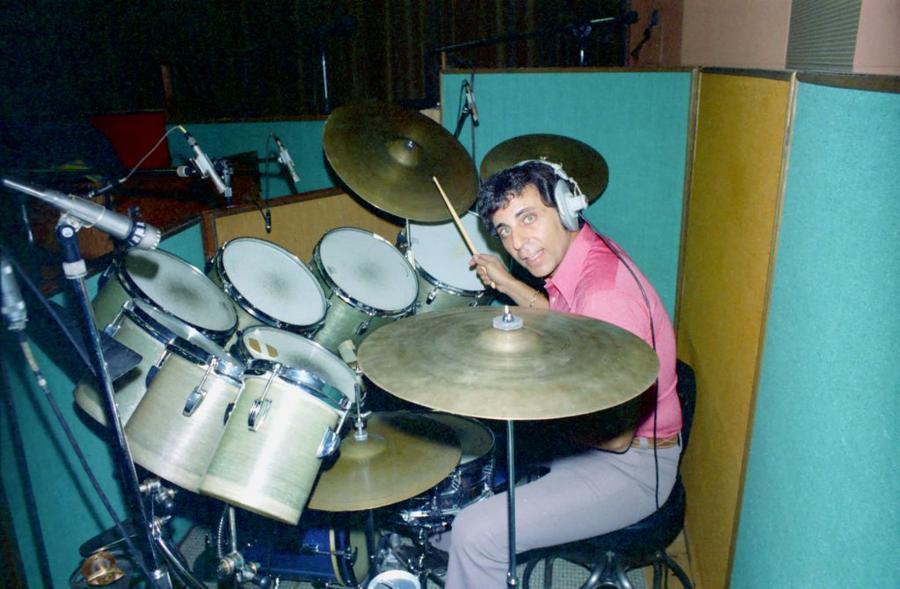What was Hal Blaine's net worth?
Hal Blaine was an American drummer and session musician who had a net worth of $500 thousand. Hal Blaine was among the most prolific studio musicians in the recording industry. One of the main members of Phil Spector's Los Angeles-based house, he played on songs by such artists as the Ronettes, Frank Sinatra, the Beach Boys, Neil Diamond, Elvis Presley, the Byrds, and John Denver. Blaine has been featured on more than 50 #1 hits and 150 Top 10 hits. He has recorded more than 35,000 pieces of music in four decades. He is a member of the Rock & Roll Hall of Fame as well as the Musicians Hall of Fame and Museum and the Percussive Arts Society Hall of Fame. Blaine holds the record for playing on six consecutive Grammy Award Record of the Year winners.
Early Life
Hal Blaine was born as Harold Belsky on February 5, 1929, in Holyoke, Massachusetts as one of four children of Rose and Meyer, Jewish immigrants from Eastern Europe. At the age of seven, he moved with his family to Hartford, Connecticut. Blaine started drumming when he was eight and received his first drum kit when he was 13. He often accompanied his father to the nightclub where his father worked, learning drum patterns from the musicians there. In 1943, the family moved to California.
Career Beginnings
Blaine began his career playing overnight sessions in strip clubs in Chicago. He went on to play with Count Basie's big band and tour with singers Patti Page and Tommy Sands. Blaine specialized in big band and jazz music before focusing on rock 'n' roll session work in the late 1950s and '60s.
Session Success
In the 1960s, Hal Blaine became one of the most prolific and sought-after session drummers in the music industry, working alongside a loosely affiliated group of elite Los Angeles studio musicians. This group was never formally named during its heyday, but in later years Blaine began referring to it as "the Wrecking Crew" — a term he helped popularize through his 1990 memoir. While the label has since become widely adopted, some members, including bassist Carol Kaye, have publicly rejected it, arguing it misrepresents the professionalism and image of the players involved.
Regardless of what the group was called, Blaine's contributions were undeniable. He was the de facto rhythmic backbone of countless hits, frequently working with producer Phil Spector and his famed "Wall of Sound." Blaine played on 150 U.S. top-10 singles, about 40 of which reached number one. His drumming can be heard on Jan and Dean's "Surf City," Gary Lewis & the Playboys' "This Diamond Ring," Barry McGuire's "Eve of Destruction," Petula Clark's "My Love," the Mamas & the Papas' "Monday, Monday," and the Association's "Windy." He also appeared on multiple hits by the Beach Boys, Simon & Garfunkel, the 5th Dimension, Neil Diamond, John Denver, and the Carpenters. From 1966 through 1971, Blaine played on six consecutive Grammy Award winners for Record of the Year — an achievement no other session musician has matched.

Hal Blaine in 1966. (Photo by Michael Ochs Archives/Getty Images)
Later Career
In the 1980s, Blaine's session work decreased as the recording industry began embracing computers and electronic instruments in the studio. The rising popularity of drum machines, in particular, took demand away from traditional session drummers. As a result, Blaine found work playing on advertising jingles, and did this for several years before semi-retiring. After a particularly rough divorce, he lost the majority of his wealth and took a job as a security guard in Arizona. The recording industry didn't forget about his prolific contributions, as he was inducted into the Rock and Roll Hall of Fame in 2000 and the Musicians Hall of Fame and Museum, as a member of the Wrecking Crew, in 2007. A year before his passing, in 2018, Blaine earned a Grammy Lifetime Achievement Award.
Artistry
As a member of the Wrecking Crew, Blaine helped usher in the Wall of Sound music production style that gained popularity in the 1960s, originating at Phil Spector's Gold Star Studios. One of his big contributions to the style was the drum pattern he created for the Ronettes' 1963 single "Be My Baby," which he invented by accidentally hitting the snare on just the fourth beat, missing the second. Blaine was also credited with popularizing the so-called disco beat, which he used on Johnny Rivers's 1966 single "Poor Side of Town." Beyond his musical contributions, part of Blaine's artistry was putting rubber stamps that read "Hal Blaine Strikes Again" on music he played on and at places where he performed.
Personal Life and Death
Blaine was married a total of six times. With his first wife, who passed away in 1968, he had a daughter. Blaine died on March 11, 2019 in Palm Desert, California at the age of 90.
/2015/08/HAL-BLAINE.jpg)
/2010/09/Phil-Spector-1.jpg)
/2012/10/dk.jpg)
/2022/04/bob.jpg)
/2016/06/Gina-Schock.jpg)
/2014/07/Carol-Kaye.jpg)
/2011/11/Nile-Rodgers-1.jpg)
/2013/11/GettyImages-872054696.jpg)
/2021/11/Mick-Hucknall.jpg)
/2009/11/Rod-Stewart.jpg)
/2020/01/Bruce-Buffer.jpg)
/2019/03/lh.jpg)
/2009/11/rw.jpg)
/2023/04/Robert-Smith.jpg)
/2013/02/GettyImages-71375168.jpg)
/2024/05/Ilia-Topuria.jpg)
/2011/01/Mira-Sorvino.jpg)
/2015/08/HAL-BLAINE.jpg)
/2014/07/Carol-Kaye.jpg)
/2010/09/Phil-Spector-1.jpg)
/2022/04/bob.jpg)
/2019/10/mama-cass.jpg)
/2021/05/bb.jpg)
/2016/06/Gina-Schock.jpg)